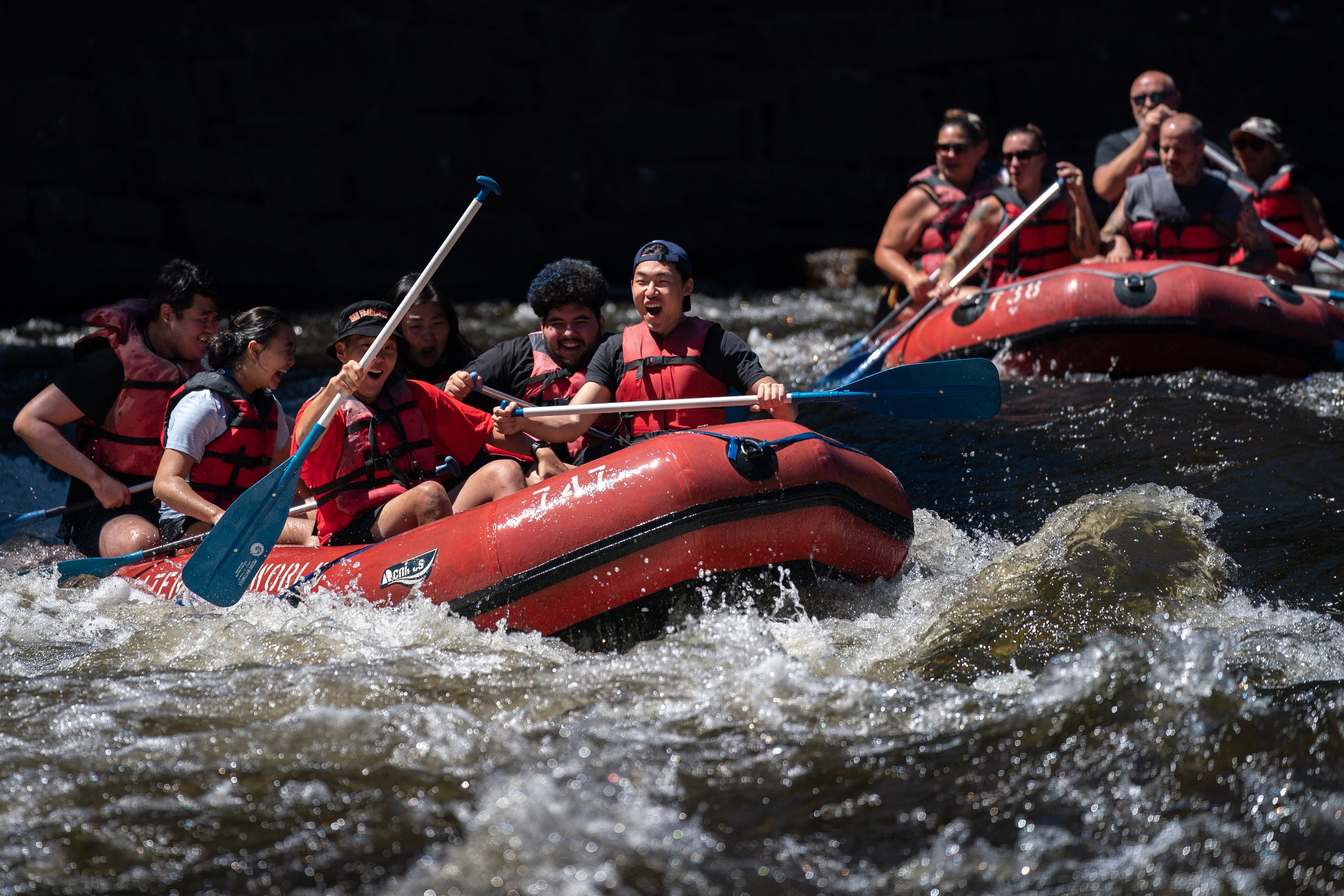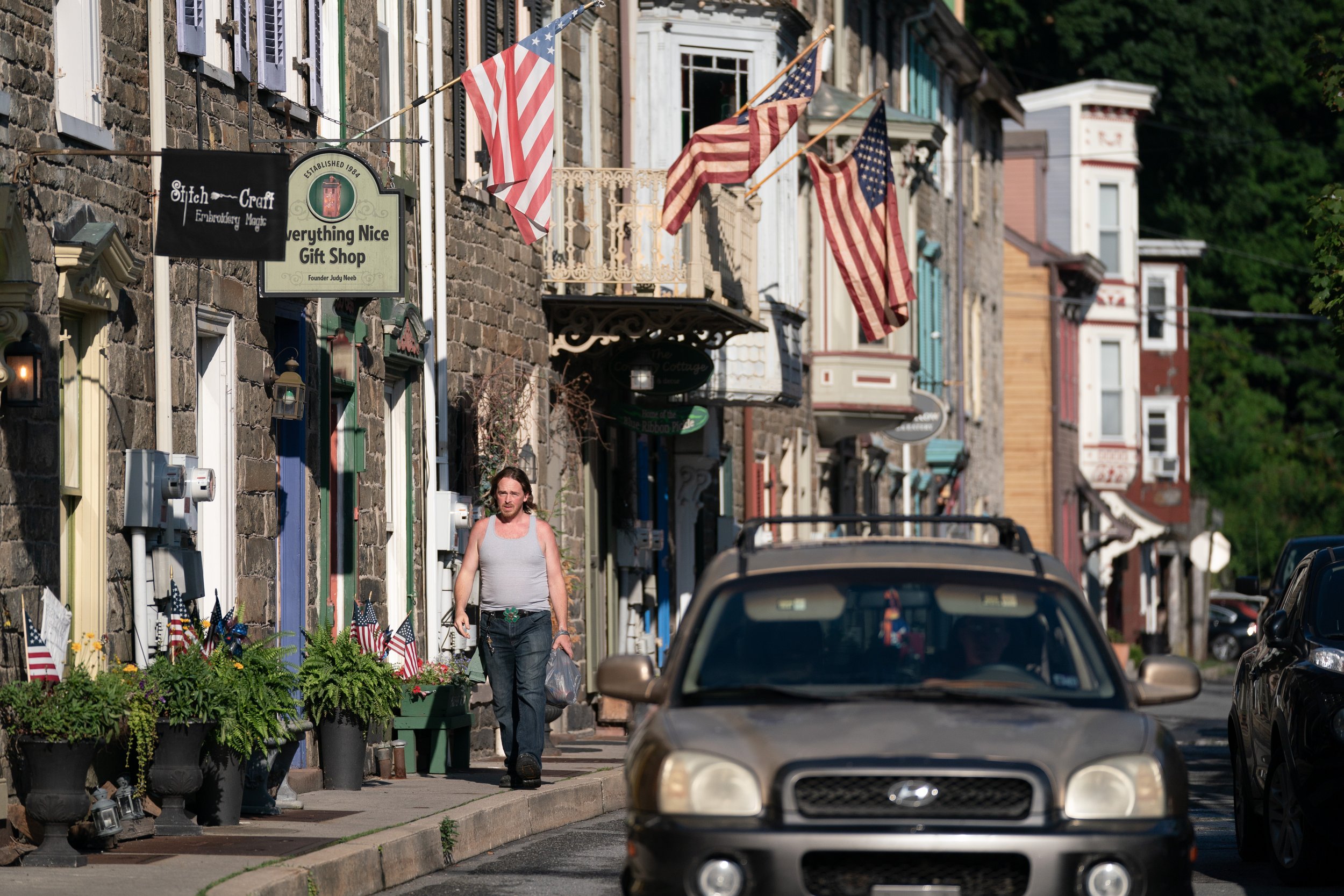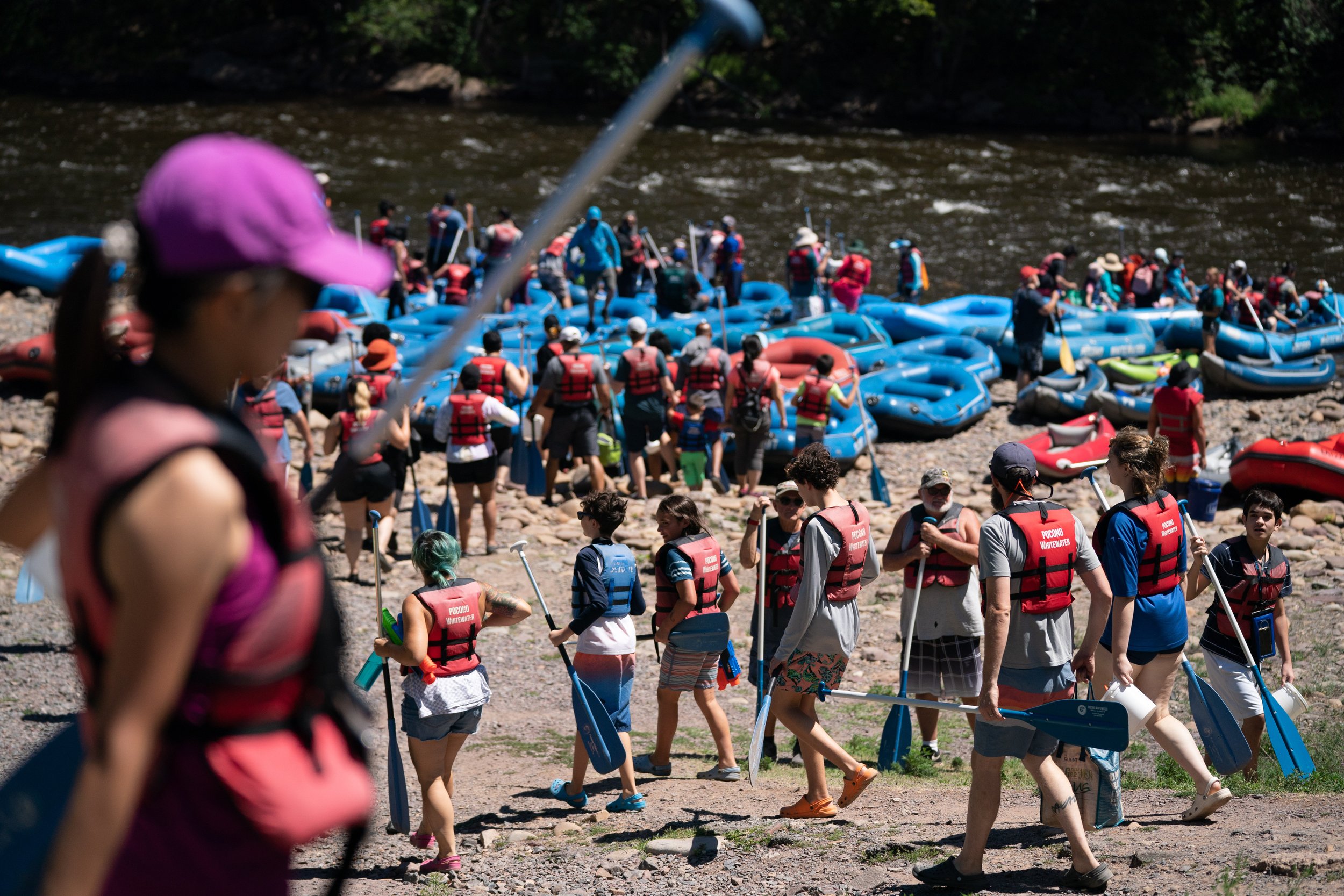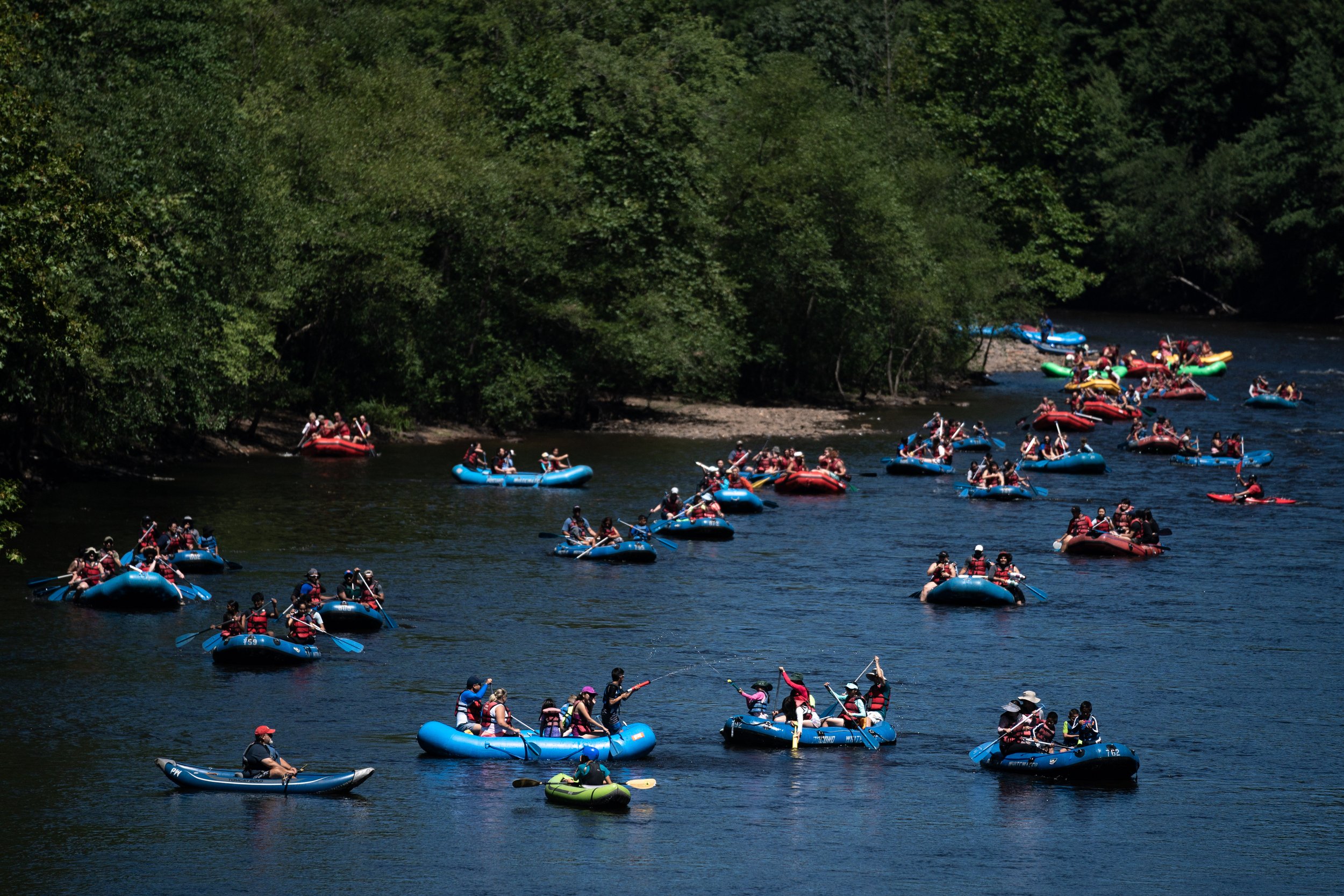Avoid Highways: Escape to the Poconos
Photos and words by Sean Rayford
Whitewater rafting on the Lehigh River in Jim Thorpe, Pa.
Turning left, off one twisting unlined road and onto another, near the Pennsylvania town of Jim Thorpe, I follow a red sign that reads “Free 100 Mile View.” Plans called for New York City today, but an August heatwave chased me to the “Gateway to the Poconos” and the rolling mountains in the northeast corner of the Keystone State. At 1400 feet it’s about 10-15 degrees cooler than Philly or NYC, and when the wind blows, as it often does, it’s delightful — especially for someone conditioned in South Carolina summers.
I’m strategically wandering — looking for a place to overnight in my van, while keeping my eyes peeled for anything interesting. Turn left? Maybe right? Continue straight?
It’s time to let curiosity take the wheel. With my stealth-like micro camper, Van Go, my options are varied. I can sleep in a street parking spot (like I did in the Bronx), a travel stop, along a secluded forest road (The Chimneys in NC), in a parking lot (Cracker Barrel), a driveway, or at an official campground. The spot just needs to be level.
Passing a new house on the right as I continue up the hill, the asphalt changes to gravel. One “S” curve later and an expansive southeastern view across the Lehigh River Valley rises from the horizon. Two large maps, one with places of interest in view, and another, of a planned residential development, provide more info for the visitor.
To the right, another red sign leads me through an open gate along the grassy ridge to a small stone parking lot. Next to a clump of chestnut oaks and an impressive but currently unused fire pit, Jake Arner sets up a table and a red canopy tent, the bed of his truck filled with cases of wine.
Locals Lauren Marks and Connor Fabian have made a summer weekend ritual out of dinner at MYST hibachi/sushi/gastropub in Jim Thorpe followed with wine at 100 Mile View at sunset.
“We’ve just been here a couple weeks. We make the wine five miles from here and pop-up on Saturdays and Sundays,” says Arner, who is eager to point out all the places you can see from where we stand. As he lists off a dozen or so places I’ve never heard of, I space out with the big view. Not until he identifies the closest grocery store do I return from my fog. When he starts talking about the campgrounds here at 100 Mile View, I’m all ears.
“I think the last camper just left. I think they might be in the convertible that you see popping up there,” he says, as a couple drives off the way I drove in, “You basically check yourself in and check yourself out. It's all automated on Tentrr.”
My 2018 Ram Promaster City micro camper-van, Van Go, during moonrise at site 1 at 100 Mile View Camping.
Arner, developing the land under his company, Awesome View Properties, pairs the wine, camping and views to promote the development and share the mountain experience he has come to enjoy. A former commercial airline pilot who went to nearby Lehighton High School, Arner has owned the property since 1990.
About 750 feet below and a mile to the north, as the crow flies, but five by road, sits the town of Jim Thorpe. Considered by many to be the greatest athlete in the world, of all-time, Jim Thorpe, the person, a Native American, played pro baseball for the New York Giants, pro football for six teams in the NFL, and founded a professional basketball team. In the 1912 Summer Olympics, Thorpe won gold medals in the decathlon and pentathlon. In terms of sports super-stars, Jim Thorpe was Babe Ruth, before Babe Ruth was Babe Ruth.
In 1954, citizens voted to change the town name from Mauch Chunk to Jim Thorpe when the athlete’s widow, Patricia Thorpe, relocated her husband’s remains here, 11 months after his death, and in exchange for a monument to his legacy. In Thorpe’s home state of Oklahoma, Governor Johnston Murray had vetoed a bill that included $25,000 for a monument to Thorpe. He said that the state shouldn’t be paying for monuments to people.
Ron Chupp, a lithographer and full time artist, started coming to Jim Thorpe to meet with his girlfriend. He, from South Bend, Indiana and she, New York. “We were looking for a place to meet where I didn't have to drive to the city.” Jim Thorpe became their spot. They got married and bought a house with a gallery and studio on Broadway about 15 years ago. When Covid-19 struck, Ron’s wife left the city and worked remotely from Jim Thorpe. She now splits time between the small town and the big city. For Chupp, his abstract art is a little more fun, but most of what he shows off in front of his gallery, are scenes of Jim Thorpe and of the Macy’s Thanksgiving Day Parade.
According to Jim Thorpe’s son, Bill Thorpe, Patricia Thorpe showed up at the funeral ceremony in Oklahoma, and with the help of the police and a hearse, hauled off his father’s body. Bill Thorpe believed Patricia Thorpe received “monetary considerations” and fought court battles over his father’s remains until his own death.
The town, like others that boomed when coal was king, busted when it wasn’t. A slow decline that began nearing the end of 19th century was punctuated with the anthracite strike of 1925. Oil would be the new king. Many residents hoped the name change, publicity and corresponding plans (an NFL Hall of Fame and a cancer research facility) would elevate the struggling county seat. Resources were scarce enough that buildings scheduled for demolition were not demolished.
In 1959, NFL commissioner Bert Bell was expected to announce plans for the Hall of Fame and research center in Jim Thorpe after a match-up between the Philadelphia Eagles and Pittsburgh Steelers. But during the game, he died.
Canton, Ohio got the Hall of Fame and the town of Jim Thorpe continued their struggle. Not until the 80’s and 90’s, as tourism grew, did the town start to see relief. The unintentionally preserved architecture, primarily Victorian, now lures travelers from around the globe.
During Mauch Chunk’s heydays, large amounts of wealth traveled along the railways through the Lehigh River Valley. Mining and moving coal out of the mountains was good business and more than a dozen millionaires had homes in Mauch Chunk. Two spectacular mansions still overlook downtown, lined with shops, hotels, restaurants, art studios, and a few residences. The Harry Packer Mansion Inn is a bed and breakfast and their next door neighbor, the Asa Packer Mansion is a museum. On Fridays and Saturdays, you do not need to be guest of the inn to visit Harry’s “Libation Lounge.” Just go to the back door, ring the bell and staff will let you in. Yuengling is $4 and if the place looks familiar it’s probably because it inspired Disney’s Haunted Mansion.
Like other booming coal towns, industry leaders and community members treated mine workers inhumanely in Mauch Chunk. In this case, Irish immigrants, many who fled their country during the potato famine, were subjected to the worst. The abuse often began when companies tricked immigrants (including children) to work the mines.
In 1877, four men were hanged in Mauch Chunk and six more in nearby Pottsville after being accused of being activists in a secret society of Irish coal miners, known as Molly Maguires. Today, in or near town, you can tour both the old jail where the miners were executed and the No. 9 Mine museum — and you can eat Shepard’s Pie at Molly Maguire’s Pub just below the two Packer mansions and across from the train station.
Hauling coal out of the mountains isn’t much of a priority these days but the railroad still holds a prominent role in Jim Thorpe. During summer weekdays, three sightseeing diesel passenger trips through the Lehigh Gorge are offered. On weekends, additional trips are available. And on occasion, a steam locomotive or two pulls into town, carrying loads of passengers while attracting rail enthusiasts from all over. The town explodes with people.
In December of 1986, Chip Burnett visited Jim Thorpe for the first time. He came with his mother and father, wife and three sons. A Philadelphia police officer, Burnett quickly fell in love with the town and told his wife that he’d like to retire here one day.
Now a part time car host with the Reading and Northern Railroad Lehigh Gorge Scenic Railway, Burnett will soon celebrate twenty years retired from the force, and living in Jim Thorpe.
“I got interested with the train when I was riding my bicycle on the D&L Trail about five years ago and met one of the conductors. And he kinda encouraged me to apply for the job,” says Burnett. His favorite part of the job is interacting with the passengers.
“It's fantastic. The power, the sounds, the smell - everything, it's intoxicating,” says Brian Wowak, “I've heard it said before, and it's true. A steam locomotive is the closet man has come to creating life. They really are like they are alive when you work with them.” From Bloomberg, PA Wowak is a conductor, fireman and an engineer trainee at Steamtown National Historic Site. On August 13, he was a passenger on the Reading and Northern Excursion.
Once, the center of a network of coal mines, stone quarries, railroads and canals fueling the Industrial Revolution in America, and once a casualty of that boom, Jim Thorpe now serves an outdoor recreation destination. Each weekend, thousands of visitors float down the rapids of the Lehigh River on kayaks, canoes and rafts. They come to ride the dozens of beginner level gravel miles on the B&L trail and others come for “some of the wildest and woolliest single-track mountain bike trails in the east,” according to The Kearney Observer.
If you didn’t bring your bicycle, Pocono Biking in Jim Thorpe or Jim Thorpe River Adventures in Lehighton have you covered with a rental. Cyclists can even hop on the the train with their bikes and pedal back down to Jim Thorpe. If you want to rent a bicycle overnight, you’ll need to use the outfitter in Lehighton. Jim Thorpe River Adventures and Pocono Whitewater both offer a variety of trips on the river.
A popular route for mountain bikers, The Switchback Trail, which I tackled on a run for about three miles, uses the path of the nation’s first railway and first roller coaster. Originally used to move coal down the mountains to the valley canals, the Switchback Gravity Railroad has evolved with the needs of those living and visiting the town.
With lighting speed at it’s inception, and most recently at a much slower pace, Jim Thorpe, has done the same - unlike many of the coal towns in the region.
RELATED CONTENT:
About the author: Sean Rayford is a South Carolina photojournalist, covering the state since 1997.























